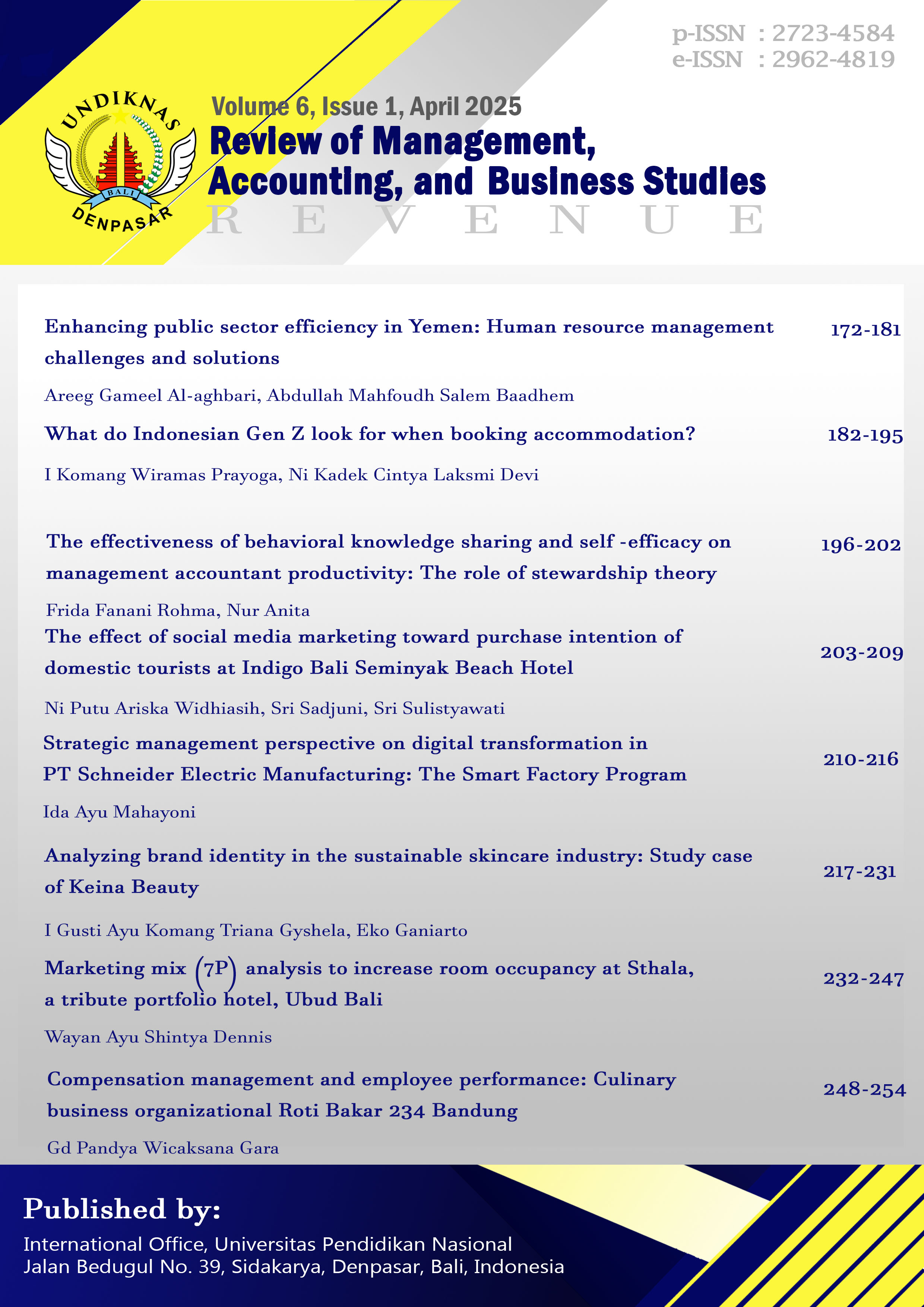Compensation management and employee performance: Culinary business organizational Roti Bakar 234 Bandung
DOI:
https://doi.org/10.38043/revenue.v6i1.6174Keywords:
Internal organization, archetype model, questionnaire survey, reward and incentivesAbstract
Internal organization is a crucial aspect for every firm in achieving its objectives, and the culinary business is no exception. Roti Bakar 234 Bandung is a culinary business that has been operating since 1970. Therefore, maintaining its internal condition is essential to sustaining a competitive advantage in the long term. The archetypal model is a concept used to analyze broad patterns rather than narrowly defined organizational features, in order to better understand organizational structure, management, and internal conditions. This study aims to examine the internal condition of Roti Bakar 234 using the archetypal model. The method employed was a questionnaire survey involving 20 employees, focusing on four dimensions: leadership-driven, market focus, knowledge core, and execution edge. The findings show that the average score for leadership-driven is 3.84, market focus is 3.90, execution edge is 3.66, and knowledge core is 3.64. The lowest score is in the knowledge core (3.64), specifically in the area of rewards and incentives.
References
Articles
Andrews, K., & Mohammed, T. (2020). Strategies for reducing employee turnover in small- and medium-sized enterprises. Westcliff International Journal of Applied Research, 4(1), 57–71. https://doi.org/10.47670/wuwijar202041KATM
Capolupo, P., Messeni Petruzzelli, A., & Ardito, L. (2024). A knowledge-based perspective on transgenerational entrepreneurship: Unveiling knowledge dynamics across generations in family firms. Journal of Knowledge Management, 28(5), 1444–1467. https://doi.org/10.1108/JKM-05-2023-0451
Claro, D. P., Plouffe, C. R., & Vieira, V. A. (2023). Sales compensation plan type and sales opportunity coverage: “Double-edged” sword effects on sales performance. Industrial Marketing Management, 113, 153–167. https://doi.org/10.1016/j.indmarman.2023.05.022
Elsafty, A., & Sayed, Y. R. (2023). Factors affecting employee turnover in a small business in Egypt. International Journal of Social Science Studies, 11(4), 14–26. https://doi.org/10.11114/ijsss.v11i4.6159
Green, C., & Miller, L. (2021). Equity-based compensation in entrepreneurial ventures.
Journal of Financial Innovation, 3(1), 45–59.
Greenwood, R., & Hinings, C. R. (1993). Understanding strategic change: The contribution of archetypes. Academy of Management Journal, 36(5), 1052–1081.
Ibañez, S., Andrade-Valbuena, L. P., & Llanos-Contreras, O. (2024). Navigating job satisfaction in family firms during crisis. Frontiers in Psychology, 15, 1285221. https://doi.org/10.3389/fpsyg.2024.1285221
Laloux, F. (2014). Reinventing organizations: A guide to creating organizations inspired by the next stage of human consciousness. Nelson Parker.
Llanos-Contreras, O., Jabri, M., & Arregle, J.-L. (2024). Navigating job satisfaction in family firms during crisis. Frontiers in Psychology, 15, 1285221. https://doi.org/10.3389/fpsyg.2024.1285221
Maslow, A. H. (1943). A theory of human motivation. Psychological Review, 50(4), 370–396. https://doi.org/10.1037/h0054346
Miller, D., & Friesen, P. H. (1984). A longitudinal study of the corporate life cycle. Management Science, 30(10), 1161–1183.
Mustafa, M., Ramos, H. M., & Zainal Badri, S. K. (2023). Determining nonfamily employees' job satisfaction and turnover intentions: The roles of job autonomy and work passion. Journal of Family Business Management, 13(2), 387–411. https://doi.org/10.1108/JFBM-08-2020-0079
Manenzhe, P., & Ngirande, H. (2021). The influence of compensation, training and development on organisational citizenship behaviour. SA Journal of Industrial Psychology, 47, a1845. https://doi.org/10.4102/sajip.v47i0.1845
Pimentel, D., Almeida, P., & Morais, Y. (2024). Organizational justice, turnover intentions and resilience in family and non-family businesses in the Portuguese hotel industry. Journal of Family Business Management. https://doi.org/10.1108/JFBM-10-2024-0241
Worley, C. G., & Mohrman, S. A. (2014). Is change management obsolete? Organizational Dynamics, 43(3), 214–224. https://doi.org/10.1016/j.orgdyn.2014.08.003
Books
Armstrong, M. (2020). Armstrong's handbook of human resource management practice (15th ed.). Kogan Page.
Champagne, P. J., & McAfee, R. B. (1989). Motivating strategies for performance and productivity: A guide to human resource development. Quorum Books.
Davis, P., & White, R. (2019). Compensation and benefit design: Applying finance and accounting principles to global human resource management systems. Pearson Education.
Robbins, S. P., & Judge, T. A. (2019). Organizational behavior (18th ed.). Pearson.
Taylor, S. (2021). Resourcing and talent management (8th ed.). CIPD Publishing.
Theses
Crosby-Hardin, Z. M. (2020). The impact of small business leadership on employee turnover (Doctoral dissertation, Walden University). Walden Dissertations and Doctoral Studies. https://scholarworks.waldenu.edu/dissertations/8875
Downloads
Published
How to Cite
Issue
Section
License
Copyright (c) 2025 Gd Pandya Wicaksana Gara

This work is licensed under a Creative Commons Attribution-ShareAlike 4.0 International License.










